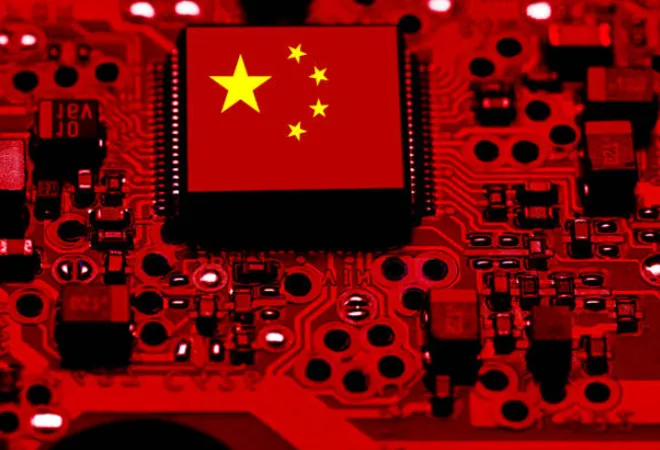-
CENTRES
Progammes & Centres
Location
The strategic foresight shown by China in the cultivation of virtual reality, artificial intelligence, and digital currencies paves China’s long march to tech supremacy

While the United States (US) is traditionally recognised for its global technological dominance, China has swiftly risen as a strong contender. Bolstered by its expansive domestic market and thriving tech sector, China poses a significant challenge to the US tech prowess. The ongoing tech conflict between the two nations encompasses diverse concerns, ning intellectual property rights, trade strategies, and matters of national security. The US has imposed sanctions on China for multiple reasons, including human rights violations, espionage, and support for Russia's actions in Ukraine. These sanctions primarily seek to limit China's technological capabilities by restricting its access to crucial technology suppliers. Nevertheless, China remains steadfast in its pursuit of developing and experimenting with emerging technologies, displaying a resolute commitment to maintaining its position at the forefront of innovation.
In China, the concept of the metaverse is gaining significant momentum, with cities like Nanjing, Shanghai, and Zhengzhou taking proactive measures to advance research and development in this virtual realm. Nanjing introduced the China Metaverse Technology and Application Innovation Platform to leverage academic and enterprise resources to strengthen metaverse-related research. Shanghai is advancing its metaverse goals, forecasting a metaverse industry revenue of 350 billion yuan by 2025. The city has unveiled a range of metaverse use cases, including virtual healthcare diagnoses and digital replicas of historic architectural landmarks.
The US has imposed sanctions on China for multiple reasons, including human rights violations, espionage, and support for Russia's actions in Ukraine.
To keep pace, Zhengzhou has unveiled a series of policy blueprints aimed at bolstering metaverse enterprises. With a formidable 10 billion yuan fund dedicated to the city’s metaverse industry, the city is ready to foster growth. Offering alluring incentives, companies relocating their headquarters to Zhengzhou stand to access substantial capital injections and a conducive environment for growth. This endeavour advances metaverse technologies, integrating them into the education and entertainment sectors.
China's committed funding and incentives reflect its determination to lead the metaverse revolution, paving the way for significant advancements in nationwide virtual reality and immersive digital landscapes.
China leads in global central bank digital currency (CBDC) development with the digital yuan. Managed by the People's Bank of China (PBOC), the digital yuan operates as a legal tender equivalent to the physical renminbi (RMB). Unlike cryptocurrencies, CBDCs fall within the sphere of government control, furnishing China with a centralised and regulated framework. The digital yuan's initial phases have been concentrated mainly in major coastal cities, progressively advancing towards a comprehensive nationwide launch.
Characterised by quicker, cost-efficient, and potentially more secure transactions, the digital yuan outperforms traditional payment mechanisms. Streamlining transactions by circumventing intermediaries like banks accelerates processing and diminishes expenses. CBDCs could provide enhanced security against financial misconduct. However, privacy, anonymity, and surveillance are areas of concern.
China's comprehensive digital yuan pilot programme, ning multiple provinces and cities, underscores its commitment to refining and exploring this technology. Through rapid expansion into urban centres and engagements like the 2023 Asian Games, where digital yuan will be used for payments for transportation, China highlights its ambition to seamlessly integrate CBDCs into mainstream payment systems, affirming its role as a global pacesetter for digital currencies.
The Digital Silk Road could extend the adoption of the digital yuan, aiding countries seeking alternatives to dollar-dependent financial structures.
Hong Kong became a digital yuan pilot region in September 2022, focusing on cross-border payment experiments. However, its adoption and success are underwhelming compared to other parts of China. Nevertheless, this endeavour aligns with larger objectives to strengthen the RMB's position in the global financial landscape. As the RMB climbs to the fifth-largest asset in foreign exchange reserves, China's actions suggest a move away from dollar dependence, offering new financial avenues.
The digital yuan's potential for internationalisation has gained further strength through initiatives like the Belt and Road Initiative (BRI). The Digital Silk Road could extend the adoption of the digital yuan, aiding countries seeking alternatives to dollar-dependent financial structures. China envisages redefining global financial dynamics by encouraging voluntary adoption of the digital yuan.
China possesses a competitive edge over many Western economies in the global Artificial Intelligence (AI) race. AI heavily depends on data, and the CCP’s ‘socialism with Chinese characteristics’ model possesses the mechanisms for amassing vast datasets. This confers an advantage to companies with affiliations to the Chinese government, enabling them to leverage state-collected data to enhance commercial endeavours.
Unlike hardware or defence manufacturing, AI generally operates under an open science model, sharing algorithms through research for knowledge transfer. This framework aids newcomers in narrowing the gap with established entities, accelerating their progress. Unlike conventional sectors that prioritise patents, AI's innovation hinges on data and talent, creating a unique competitive edge.
AI heavily depends on data, and the CCP’s ‘socialism with Chinese characteristics’ model possesses the mechanisms for amassing vast datasets.
China's strategic advantage lies in its wealth of data and a highly skilled pool of computer scientists and engineers. Market dynamics also drive diverse AI applications and nurture innovation. With favourable policies and flexibility, China's AI sector exhibits remarkable growth, nurturing pioneering enterprises.
The ongoing tech war between the US and China is characterised by escalating tensions, with semiconductors at the centre of the dispute. The trade war, which began during the Trump administration, has intensified under President Biden as the US seeks to hinder China's progress in high-tech industries.
The US Bureau of Industry and Security has identified approximately 600 Chinese entities—including Chinese telecom and consumer electronics giant Huawei—and put them on the Entity List, comprising companies and research institutions involved in military technology, 5G, AI, and advanced technologies.
The competition between the US and China has global implications, affecting markets, supply chains, and trade dynamics.
The US’ action against Chinese companies has evoked strong counter-responses from China. China's Ministry of Commerce recently added two companies, Lockheed Martin Corporation and Raytheon Missiles and Defense, to its unreliable entities list. Following this move, Lockheed Martin and Raytheon Missiles and Defense will face restrictions on arms sales to Taiwan. The action also bars them from China-related import or export activities and prohibits new investments in China.
Despite the US’s efforts to obstruct China's advancements, the country has emerged as a dominant force in critical sectors like robotics, AI, and quantum technology. While the US focuses on semiconductor control, China's leadership extends to various key areas, positioning it as a leading technology superpower. The competition between the US and China has global implications, affecting markets, supply chains, and trade dynamics. Europe has also entered the fray, imposing restrictions on Chinese entities to safeguard national security.
The struggle for tech supremacy is complex and multi-faceted, with each nation vying to secure a lasting edge. Nevertheless, the US and Europe have not devoted comparable levels of time and strategic foresight as China in the cultivation of virtual reality, artificial intelligence, and digital currencies. Given the profusion of both talent and data, these advancements are poised to continue China’s unabated progress.
Sauradeep Bag is Associate Fellow at Observer Research Foundation.
The views expressed above belong to the author(s). ORF research and analyses now available on Telegram! Click here to access our curated content — blogs, longforms and interviews.

Sauradeep is an Associate Fellow at the Centre for Security, Strategy, and Technology at the Observer Research Foundation. His experience spans the startup ecosystem, impact ...
Read More +